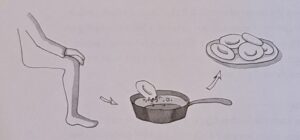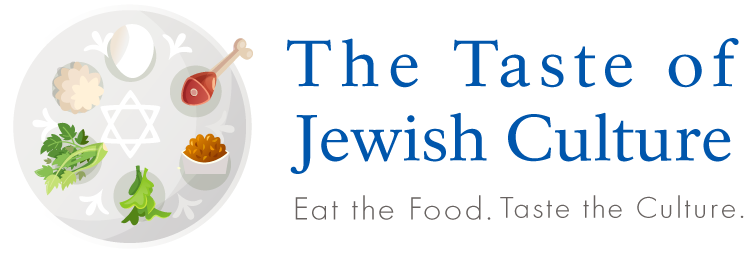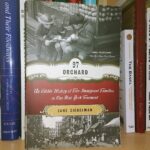I have written previously about the effects of the Holocaust on Jewish cuisine, most prominently in the breaking of the chain of transmission from generation to generation. This resulted in a tremendous amount of cultural knowledge being lost. We do have a few books that can help us learn about pre-war European Jewish food. For example, there is a unique text called The Jews of Poland: Recollections and Recipes, written by Edouard de Pomiane. While it was written by a non-Jew from Paris, and is certainly not flawless, it provides a singular window into the titular community’s cuisine during the inter-war period. Jews themselves also produced a limited number of cookbooks in pre-WWII Europe. Another interesting one was recently reprinted in translation: Fania Lewando’s The Vilna Vegetarian Cookbook.” Those sources, however, are far from sufficient to encapsulate an entire cuisine.
So, as I noted in that previous post, there are a few ways in which people in contemporary times have attempted to combat that blow, and minimize the loss that we collectively experienced. One of the methods I described was scholarly research into the past, compiled into books. The above-mentioned surviving records provide one source for these studies, but they must also be suplemented by interviews with survivors, as well as a deeper dive into a broader array of archival materials. I highlighted in that previous post two books of this type in particular, one of which I previously covered in a “From the Jewish Food Bookshelf” post. Today, I want to look at the other: The German-Jewish Cookbook by the mother-daughter team of Gabrielle Rossmer Gropman and Sonya Gropman.
Digging into German-Jewish Food
So what’s inside The German-Jewish Cookbook? It is not like most standard cookbooks, primarily focused on recipes, along with a few introductory head notes for each recipe. As this book’s subtitle states, it contains both the “Recipes & History of a Cuisine.” There is a comprehensive essay looking at the history of German Jewry and the foods they ate. Furthermore, scattered throughout the book and interspersed with the recipes are short essays about some of the individual foods, and the people the authors interviewed.
However, where Koerner’s book on Hungarian-Jewish food was primarily a book of research-based writing using the recipes as supporting materials, the Gropmans move to the other side of the spectrum for this book. The recipes are definitely the primary focus while the other material is there to illustrate and flesh out those foods. Koerner’s is highly academic, while this book is more user-friendly with some scholarly support.
An interesting example of the type of material the Gropmans include here breaks German-Jewish food down into three categories: German dishes that needed to be adapted and altered for kashrut purposes, Jewish foods that were largely eaten for Shabbat and holidays specifically, and general German foods that required no alterations. Accordingly, the recipe sections in this book are broken down differently than in most cookbooks I have seen. While there are separate sections for certain food types — vegetables, for example — the foods are primarily grouped by the circumstances in which they would be comsumed. So for example, there are sections for Shabbat/holiday meals and weekday meals, as well as a section for food at parties (including coffee and cake).
Some Interesting German-Jewish Recipes

Many Jews are familiar with stuffed cabbage (and in fact stuffed foods are something of a trademark of Jewish cooking). But the best known version is Hungarian in style, with rice and chopped meat inside, and a sweet-and-sour, tomato-based sauce coating the cabbage rolls. But German (and German-Jewish) cuisine bore a certain sublime elegance at times, and we see it in the stuffed cabbage recipe here. It features bread dough in place of the rice, and a light white wine sauce. White wine also finds its way into the potato salad featured here, along with sweet onion, hard-boiled eggs, vinegar, and Dijon mustard.
Jewish cooking everywhere has created dishes that frugally repurpose leftovers and/or utilize scraps that would have been discarded. (I wrote an article for The Nosher highlighting some of them.) One example from this book is Hoppel-Poppel, a sort of frying-pan-scramble that combones leftover starch, vegetables, and meat with an egg binder.
Finally, a few of the foods for Sabbath and holidays are not the same as ones that are more commonly known in America, making for interesting alternatives. Berches is the classic German version of challah bread, made without egg and enriched/softened instead by the includion of a mashed potato! Rather than hamantaschen (which are actually German in origin), the book includes a recipe for “Haman” — pastries that are actually shaped (a la gingerbread men) like the villain of the story. For Chanukkah, we encounter doughnuts, but a special one in place of the jelly-filled standards. Called “Knee Doughnuts” these simple yeasted examples are shaped over the cook’s (pre-cleaned) knees, before being fried! And for a simple Passover breakfast, we are given “Matzo Coffee,” which is just like it sounds: matzo pieces crumbled into a large cup of coffee, with milk and sugar added.
Overall, the Gropmans’ lovely book is well-researched, comprehensive, pleasantly illustrated, and informative. But it deserves extra points for helping to preserve a specific cuisine that was in danger of being lost forever. An excellent addition to any Jewish Food Bookshelf!
Think Das Ist Gut? Pass it Along!






